2010年10月20日生效的日本食品添加剂标准
日本添加剂国家法规

添加物一般の使用基準1. 別に既定するもののほか、添加物の製剤に含まれる原料たる添加物について、使用基準が定められている場合は、当該添加物の使用基準を当該製剤の使用基準とみなす。
2. 次の表の第1欄に掲げる添加物を含む第2欄に掲げる食品を、第3欄に掲げる食品の製造又は加工の過程で使用する場合は、それぞれ第1欄に掲げる添加物を第3欄に掲げる食品に使用するものとみなす各添加物の使用基準及び保存基準(平成19年10月26日改正まで記載)(厚生省告示第370号 食品、添加物等の規格基準より抜粋) *記載のない場合は対象食品の規制は使用できる食品等*使用量等の最大限度使用制限漂白剤かんきつ類果皮(菓子製造に用いるものに限る)殺菌料さくらんぼふきぶどうももかずのこの調味加工品(干しかずのこ及び冷凍かずのこを除く。
)生食用野菜類卵類(卵殻の部分に限る。
)亜酸化窒素製造用剤ホイップクリーム類(乳脂肪分を主成分とする食品又は乳脂肪代替食品を主要原料として泡立てたものをいう。
)アジピン酸酸味料亜硝酸根としての最大残存量食肉製品鯨肉ベーコン魚肉ソーセージ魚肉ハムいくらすじこたらこ強化剤酸化防止剤L-アスコルビン酸2-グルコシド強化剤L-アスコルビン酸ステアリン酸エステル強化剤L-アスコルビン酸ナトリウム酸化防止剤L-アスコルビン酸パルミチン酸エステル調味料強化剤アスパルテーム甘味料砂糖代替食品15g/kg チューインガム 5.0g/kg あん類菓子(除チューインガム)L-アスパラギン酸ナトリウムアセスルファムカリウム甘味料特別の用途表示の許可又は承認を受けた場合はこの限りではない2.5g/kgL-アスコルビン酸亜硝酸ナトリウム発色剤0.070g/kg 0.050g/kg 0.0050g/kg 品名分類使用基準亜塩素酸ナトリウム最終食品の完成前に分解し、又は除去すること0.50g/kg浸漬液生菓子アイスクリーム類ジャム類たれ、漬物氷菓フラワーペースト栄養機能食品(錠剤に限る) 6.0g/kg 果実酒、雑酒清涼飲料水乳飲料乳酸菌飲料はっ酵乳(希釈して飲用に供する飲料水は、希釈後の飲料水)その他の食品0.35g/kgアセトアルデヒドアセト酢酸エチルアセトフェノンガラナ豆ガラナ飲料を製造する際のガラナ豆の成分を抽出する目的及び油脂の成分を分別する目的に限る。
日本水产品中添加剂限量标准
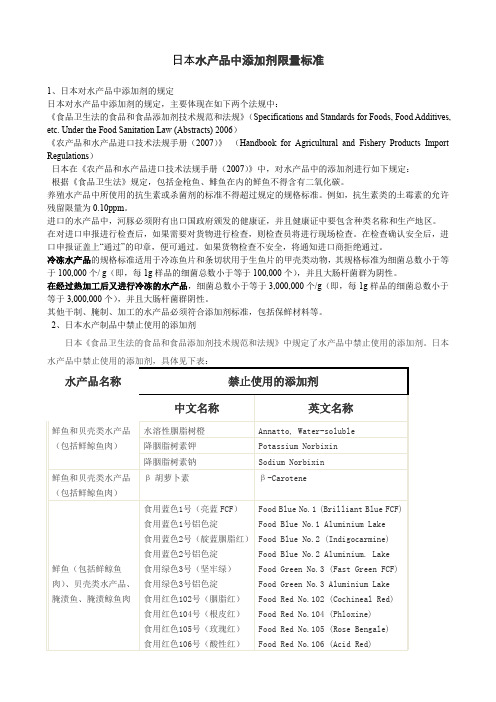
日本水产品中添加剂限量标准1、日本对水产品中添加剂的规定日本对水产品中添加剂的规定,主要体现在如下两个法规中:《食品卫生法的食品和食品添加剂技术规范和法规》(Specifications and Standards for Foods, Food Additives, etc. Under the Food Sanitation Law (Abstracts) 2006)《农产品和水产品进口技术法规手册(2007)》(Handbook for Agricultural and Fishery Products Import Regulations)日本在《农产品和水产品进口技术法规手册(2007)》中,对水产品中的添加剂进行如下规定:根据《食品卫生法》规定,包括金枪鱼、鲱鱼在内的鲜鱼不得含有二氧化碳。
养殖水产品中所使用的抗生素或杀菌剂的标准不得超过规定的规格标准。
例如,抗生素类的土霉素的允许残留限量为0.10ppm。
进口的水产品中,河豚必须附有出口国政府颁发的健康证,并且健康证中要包含种类名称和生产地区。
在对进口申报进行检查后,如果需要对货物进行检查,则检查员将进行现场检查。
在检查确认安全后,进口申报证盖上“通过”的印章,便可通过。
如果货物检查不安全,将通知进口商拒绝通过。
冷冻水产品的规格标准适用于冷冻鱼片和条切状用于生鱼片的甲壳类动物,其规格标准为细菌总数小于等于100,000个/ g(即,每1g样品的细菌总数小于等于100,000个),并且大肠杆菌群为阴性。
在经过热加工后又进行冷冻的水产品,细菌总数小于等于3,000,000个/g(即,每1g样品的细菌总数小于等于3,000,000个),并且大肠杆菌群阴性。
其他干制、腌制、加工的水产品必须符合添加剂标准,包括保鲜材料等。
2、日本水产制品中禁止使用的添加剂日本《食品卫生法的食品和食品添加剂技术规范和法规》中规定了水产品中禁止使用的添加剂。
日本。
日本食品添加物使用标准列表(2009年3月2日更新)
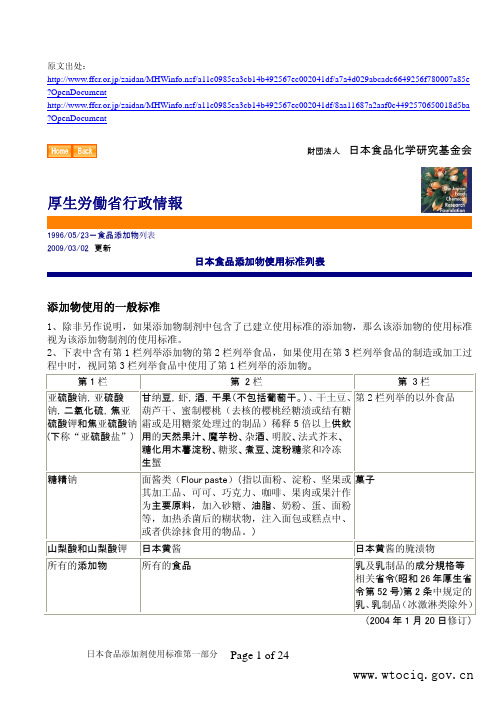
(鲑鱼、鳟鱼等 的)咸鱼子 咸大马哈鱼子 鳕鱼子
強化剤 抗氧化剂
0.0050g/kg
日本食品添加剂使用标准第一部分 Page 2 of 24
L -抗坏血酸 2 -葡萄糖苷 強化剤
L -抗坏血酸硬脂酸 L -抗坏血酸钠
強化剤 抗氧化剂
L -抗坏血酸棕榈酸酯
L -天冬氨酸钠
其他的罐藏或瓶 0.25g/kg 藏食品
醚类
香料
异抗环血酸
抗氧化剂 鱼饼(鱼糜除外) 面包
不可用于增香以外目 的。
不可用于增香以外目 的。 仅可用作口香糖基础 剂 不可用于增香以外目 的。
成品前,乙二胺四乙酸 二钠必须转化为乙二 胺四乙酸钙二钠。
不可用于增香以外目 的。 用于鱼饼(鱼糜除外) 和面包中时,不可作为 营养目的使用。
甘油磷酸钙 甘草酸苷二钠 葡糖酸内酯 葡糖酸 (葡糖酸液) 葡萄糖酸锌
葡萄糖酸钾 葡萄糖酸钙 葡萄糖酸亚铁
葡萄糖酸铜
葡萄糖酸钠 L -谷氨酸 L -谷氨酸钾 L -谷氨酸钙 L 一谷氨酸钠 L -谷氨酸镁
強化剤
甜味剂 酸化剂
酱油 日本黄酱
以钙计 1.0%(特殊用 不可用于营养以外目
异硫氰酸盐类(通常认为 高毒的品种除外。)
异硫氰酸丙烯酯(丙烯芥 油)
异丁醇
异丁醛
异丙醇
L -异亮氨酸
調味料 強化剤
5' -肌苷酸二钠
調味料
抑霉唑
防霉剂
吲哚及其衍生物
香料
柑橘类(蜜柑除 外)
香蕉
最大残留量 0.0050g/kg
0.0020g/kg
5' -尿苷酸二钠 γ-十一碳酸内酯
原文出处: http://www.ffcr.or.jp/zaidan/MHWinfo.nsf/a11c0985ea3cb14b492567ec002041df/a7a4d029abcade6649256f780007a85e ?OpenDocument http://www.ffcr.or.jp/zaidan/MHWinfo.nsf/a11c0985ea3cb14b492567ec002041df/8aa11687a2aaf0c4492570650018d5ba ?OpenDocument
日本食品标签法规简介

食品添加剂的标示规定
参见日本食品标签上标示项目的规定中 其他表示事项
1.添加剂及其制剂的表示
日本食品标签法规简介
谢 谢!
日本食品标签法规简介
3rew
演讲完毕,谢谢听讲!
再见,see you again
日本食品标签法规简介
常情况下按箱出售时,也可将所需的标示记载于硬纸板箱上。 1.4标示方法,可采用直接印刷于包装容器上的方法、盖印的方法、
贴背面有粘胶的标签方法、或用瓜标签的方法。但挂标签的方 法,仅限于就其包装形态来看不能使用其他方法的情况,并且, 应指导不要把用过的标签不正确的重复使用。 1.5加工年月日不得用略号标示。加工厂所在地及加工业者姓名不 得用记号标示。
生产厂或加工厂厂名的表示
1)作为法人,要表示出法人姓名。但是鉴于该包装容器 的标签面积、形状等不同,可以按如下表示:
i.可以将株式会社简略表示为“KK”或“(株)”、合 名会社为“(名)”、合资会社为“(资)”、有限 会社为“(有)”。
ii.可以将农业协会组合简略表示为“农协”,经济农业 协同组合连合会表示为“经济连”。
i.地方自治法规定的指定城市及县厅所在城市的道府县 名称,可以省略。
ii.在统一道府县内,街村名称不同时,可以省略郡名。 2)对于进口商品,可以用进口商经营部地址代替生产厂
厂址。 3)对生产的肉食制品,或进口后进行再加工的产品,要
注明生产厂(进口商品为进口商经营部)及加工厂厂 址。
日本食品标签法规简介
日本食品标签法规简介
生产日期或加工日期的表示
1) 生产日期(包括加工日期,以下同)的表示,要在日期前加注 “生产日期”或在后面加注“生产”,使之可以清楚地辨认其 生产日期。但是难于辨认这些表示时,可以采用在指定位置注 明“生产日期○ ○ ○”的方法,单独注明年月日。
日本复合食品添加剂的有关法规及其同中国的比较
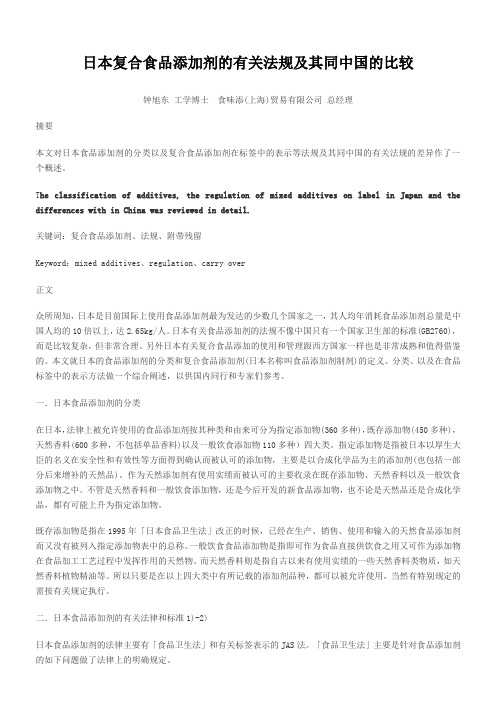
日本复合食品添加剂的有关法规及其同中国的比较钟旭东工学博士食味添(上海)贸易有限公司总经理摘要本文对日本食品添加剂的分类以及复合食品添加剂在标签中的表示等法规及其同中国的有关法规的差异作了一个概述。
T he classification of additives, the regulation of mixed additives on label in Japan and the differences with in China was reviewed in detail.关键词:复合食品添加剂、法规、附带残留Keyword:mixed additives、regulation、carry over正文众所周知,日本是目前国际上使用食品添加剂最为发达的少数几个国家之一,其人均年消耗食品添加剂总量是中国人均的10倍以上,达2.65kg/人。
日本有关食品添加剂的法规不像中国只有一个国家卫生部的标准(GB2760),而是比较复杂,但非常合理。
另外日本有关复合食品添加的使用和管理跟西方国家一样也是非常成熟和值得借鉴的。
本文就日本的食品添加剂的分类和复合食品添加剂(日本名称叫食品添加剂制剂)的定义、分类、以及在食品标签中的表示方法做一个综合阐述,以供国内同行和专家们参考。
一.日本食品添加剂的分类在日本,法律上被允许使用的食品添加剂按其种类和由来可分为指定添加物(360多种),既存添加物(450多种),天然香料(600多种,不包括单品香料)以及一般饮食添加物110多种)四大类。
指定添加物是指被日本以厚生大臣的名义在安全性和有效性等方面得到确认而被认可的添加物,主要是以合成化学品为主的添加剂(也包括一部分后来增补的天然品)。
作为天然添加剂有使用实绩而被认可的主要收录在既存添加物、天然香料以及一般饮食添加物之中。
不管是天然香料和一般饮食添加物,还是今后开发的新食品添加物,也不论是天然品还是合成化学品,都有可能上升为指定添加物。
日本修订食品和食品添加剂残留限量标准
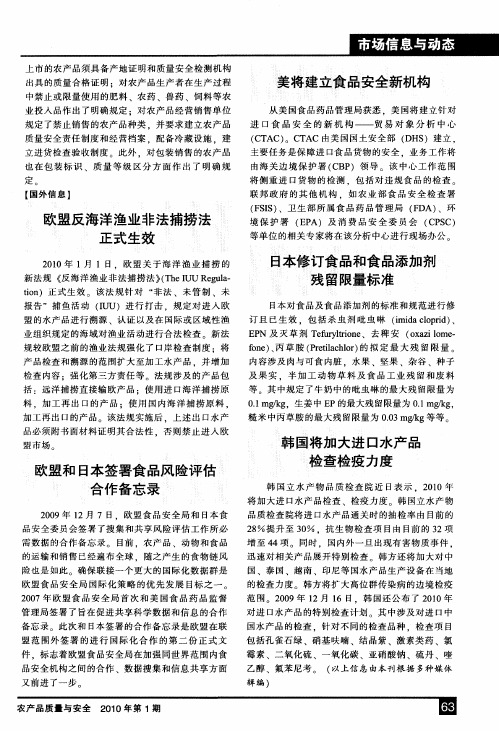
境保护署 (P E A)及 消 费 品 安 全 委 员 会 ( P C) C S
欧盟反海洋渔业非法捕捞法 正 式 生效
21 0 0年 1月 1 E .欧盟 关 于 海 洋 渔业 捕 捞 的 t
新 法 规 《 海 洋 渔 业 非 法 捕 捞 法 》 T eI U e ua 反 (h U R g l.
韩 国立 水 产 物 品 质检 查 院近 日表示 .2 1 0 0年 将 加大 进 口水 产 品检查 、检疫力 度 。韩 国立水产 物 品质检 查 院将 进 口水 产 品通关 时的抽 检率 由 目前 的
2 提 升至 3 % .抗 生物 检查 项 目由 目前 的 3 8 0 2项 增至 4 4项 。同时 ,国 内外 一旦 出现有 害物 质事件 。
等单 位 的相 关专 家将在 该分 析 中心进 行现 场办公
日本修订食品和食品添加剂
残 留限量标 准
日本 对食 品及食 品添加 剂 的标 准 和规范 进行 修 订 且 已生效 ,包 括 杀 虫 剂 吡 虫 啉 ( d l r ) i ac pi 、 mi o d E N 及 灭 草剂 T frlin 、去 稗 安 ( x z lme P ea toe iyr o aio . fn ) 丙 草胺 (rtaho) 拟 定 最 大 残 留 限量 。 oe 、 Pe lc lr 的 i
内容 涉及 肉与可食 内脏 ,水果 、坚 果 、杂谷法规 针 对 “ 法 、未 管 制 、未 o 非 报告 ”捕鱼 活 动 ( U)进 行 打击 .规 定对 进入 欧 I U 盟 的水产 品进行 溯源 、认证 以及 在 国际或 区域性 渔 业 组织规 定 的海 域对 渔业活 动进行 合法 检查 新 法
卫生部公告2010年第12号--关于磷酸酯双淀粉等14个食品添加剂的质量规格标准的公告
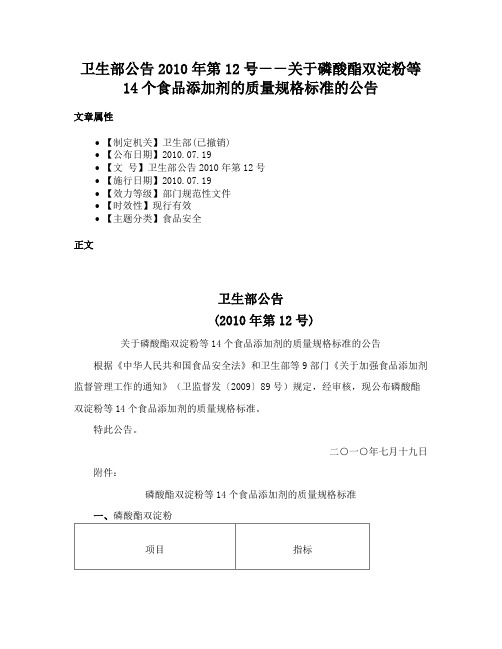
卫生部公告2010年第12号--关于磷酸酯双淀粉等14个食品添加剂的质量规格标准的公告
文章属性
•【制定机关】卫生部(已撤销)
•【公布日期】2010.07.19
•【文号】卫生部公告2010年第12号
•【施行日期】2010.07.19
•【效力等级】部门规范性文件
•【时效性】现行有效
•【主题分类】食品安全
正文
卫生部公告
(2010年第12号)
关于磷酸酯双淀粉等14个食品添加剂的质量规格标准的公告根据《中华人民共和国食品安全法》和卫生部等9部门《关于加强食品添加剂监督管理工作的通知》(卫监督发〔2009〕89号)规定,经审核,现公布磷酸酯双淀粉等14个食品添加剂的质量规格标准。
特此公告。
二○一○年七月十九日附件:
磷酸酯双淀粉等14个食品添加剂的质量规格标准
二、醋酸酯淀粉。
日本最新食品添加剂种类和使用标准分析
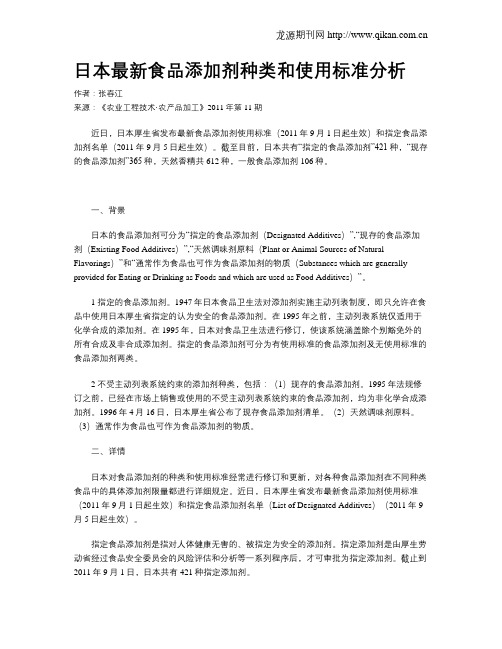
日本最新食品添加剂种类和使用标准分析作者:张春江来源:《农业工程技术·农产品加工》2011年第11期近日,日本厚生省发布最新食品添加剂使用标准(2011年9月1日起生效)和指定食品添加剂名单(2011年9月5日起生效)。
截至目前,日本共有“指定的食品添加剂”421种,“现存的食品添加剂”365种,天然香精共612种,一般食品添加剂106种。
一、背景日本的食品添加剂可分为“指定的食品添加剂(Designated Additives)”,“现存的食品添加剂(Existing Food Additives)”,“天然调味剂原料(Plant or Animal Sources of Natural Flavorings)”和“通常作为食品也可作为食品添加剂的物质(Substances which are generally provided for Eating or Drinking as Foods and which are used as Food Additives)”。
1 指定的食品添加剂。
1947年日本食品卫生法对添加剂实施主动列表制度,即只允许在食品中使用日本厚生省指定的认为安全的食品添加剂。
在1995年之前,主动列表系统仅适用于化学合成的添加剂。
在1995年,日本对食品卫生法进行修订,使该系统涵盖除个别豁免外的所有合成及非合成添加剂。
指定的食品添加剂可分为有使用标准的食品添加剂及无使用标准的食品添加剂两类。
2 不受主动列表系统约束的添加剂种类,包括:(1)现存的食品添加剂。
1995年法规修订之前,已经在市场上销售或使用的不受主动列表系统约束的食品添加剂,均为非化学合成添加剂。
1996年4月16日,日本厚生省公布了现存食品添加剂清单。
(2)天然调味剂原料。
(3)通常作为食品也可作为食品添加剂的物质。
二、详情日本对食品添加剂的种类和使用标准经常进行修订和更新,对各种食品添加剂在不同种类食品中的具体添加剂限量都进行详细规定。
日本修订食品添加剂标准和规范
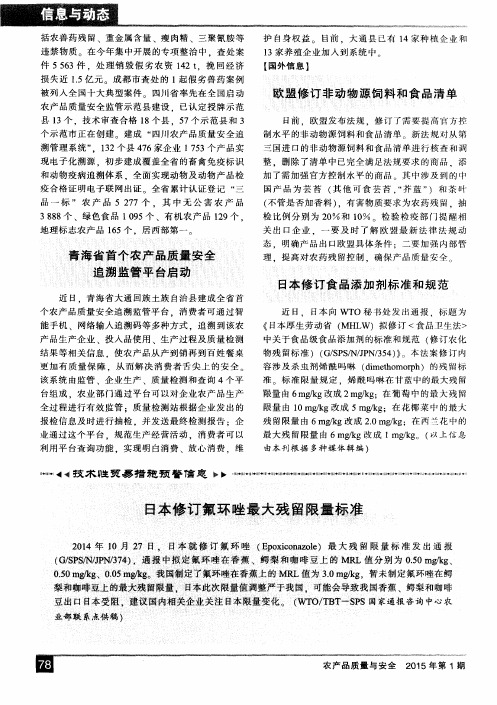
农产 品质量 与安全
2 0 1 5年第 1期
t
c . - n
…
+
本修订 氟环唑 最大残 留限量标 准
2 0 1 4年 l 0月 2 7 日 。 日本 就 修 订 氟 环 唑 ( E p o x i c o n a z o l e ) 最 大 残 留 限 量 标 准 发 出 通 报
( G / S P S / N /  ̄N / 3 7 4 ) ,通报中拟定氟环一在香蕉、鳄梨和咖啡豆上的 MR L值分别为 O 5 0 m e T  ̄ g 、 0 . 5 0 m g / k 0 . 0 5 mg , k g O我国制定了氟环唑在香蕉上的A Ⅱ 值为 3 , 0 me T  ̄ g ,暂未制定氟环唑在鳄
更 加有 质 量保 障 ,从而 解 决 消费 者舌 尖 上 的安 全 。
《日本厚 生劳 动省 ( MHL W)拟修订 <食 品卫生 法> 中关 于食 品级 食 品添加剂 的标 准和规 范 ( 修订 农化
物残 留标 准 )( G / S P S / N/ J P N/ 3 5 4 ) 》 本 法 案修 订 内
农产 品质量 安全 监管示 范 县建设 .已认 定 授牌示 范 县 1 3个 ,技术 审查合 格 1 8个县 .5 7个 示范 县 和 3
【 国外信 息 】
欧 盟 修 订 非 动物 源饲 料 和食 品 清 单
日前 .欧盟 发布法 规 .修订 了需要 提 高官 方控
个示 范市正 在创 建 。建 成 “ 四川农 产 品质量 安全 追 溯管理 系 统” .1 3 2个县 4 7 6家 企业 l 7 5 3个 产 品实
由本 刊 根 据 多 种 媒 体 辑 编 )
报 检信 息及 时进行 抽检 ,并发 送最 终检 测报 告 :企 业通 过这 个平 台 .规范 生产经 营活 动 .消费 者可 以
日本食品添加剂标准中文
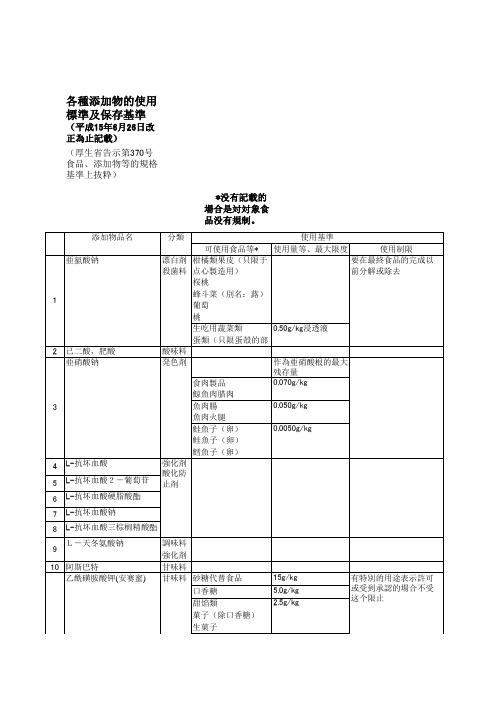
以標準調乳濃度在調 乳時、銅為0.60mg/L (対厚生大臣承認的 在調製粉乳中使用的 場合除去)
98 L-谷氨酸 99 L-谷氨酸钾
調味料 強化剤 調味料
L-谷氨酸钙 100
調味料
钙為1.0%(除去特別 用途表示的食品)
L-谷氨酸钠 101 102 L-谷氨酸镁
0.30g/kg
羧甲基繊維钙 65
羧甲基繊維钠 66
b-胡萝卜素
67
糊料
着色料 強化剤
68 蟻酸异戊基 69 甲酸香叶酯 70 甲酸香茅酯 71 希釈過酸化苯酰
72 木糖醇 D-木糖
73
74 鸟苷酸二钠 75 愈创木脂
76 檸檬酸 檸檬酸异丙基
77
香料
小麦粉 小麦粉 処理剤 甘味料 甘味料 製造用 剤 調味料 酸化防 油脂 止剤 黄油 酸味料 酸化防 油脂 止剤 黄油
面包
対魚肉餡製品(不含磨 碎魚肉)及面包、不能 以营养為目的使用
其他的食品 強化剤
膨張剤
対其他食品只能用在酸 化保防存止基的準目:的放入遮光密 封容器、空気換成不活 性気体、低温保存
調味料
強化剤
豆腐用 凝固剤 強化剤
钙1.0%(除去特別用 食品的製造或加工上必 途表示的食品) 不可缺的場合及栄養目
的以外不可使用
鲑魚子(卵)
鱈魚子(卵)
強化剤
酸化防
止剤
6 L-抗坏血酸硬脂酸酯
7 L-抗坏血酸钠
8 L-抗坏血酸三棕榈精酸酯
L-天冬氨酸钠 9
10 阿斯巴特 乙酰磺胺酸钾(安赛蜜)
調味料 強化剤 甘味料 甘味料 砂糖代替食品
口香糖 甜馅類 菓子(除口香糖)
日本食品卫生法及实施细则(中文)

2003年3月
JETRO
标准信息服务署
前言
为了更广泛地向国外团体介绍日本的法规和相关法律及体系,JETRO编辑出版了本英文材料。其目的就是为了扩大影响范围,介绍日本在开放市场方面所采取的措施以及法规和标准的主要条款,促进对外出口和熟悉国外的工业标准化,以及提高国际上对日本体系的理解。
我们希望本出版读物对您了解日本法律、标准和体系有所帮助。
格式8(与第18-8条相关) 88
格式9(与第18-8条相关) 89
格式10(与第18-9条相关) 90
格式11(与第18-10条相关) 91
格式12(与第18-11条相关) 92
格式13(与第18-13条相关) 93
格式14(与第23条相关) 95
格式15(与第24条相关) 100
表格1(与第2条相关) 101
(3)那些被致病菌污染或怀疑被污染,并可能危害人类健康的食品或添加剂;
(4)那些由于不清洁、混合或添加剂的物质或其它原因造成的可能危害人类健康的食品或添加剂;
(备注)
1>第4条(2)条款:健康、劳动和福利部法规23号(下文中指“部法规”)的第1条
[对新生食的人限制销售]
第5章 商务[第19-21条] 70
第6章 杂项条款[第22-25条] 73
格式和表格
格式1(与第18条相关) 75
格式2(与第18条相关) 76
格式3(与第18条相关) 78
格式4(与第18条相关) 82
格式5(与第18-3条相关) 83
格式6(与第18-4条相关) 86
格式7(与第18-7条相关) 87
2003年3月
日本外贸组织信息服务部
2-5,Toranomon 2-chome
日本食品级检测简介
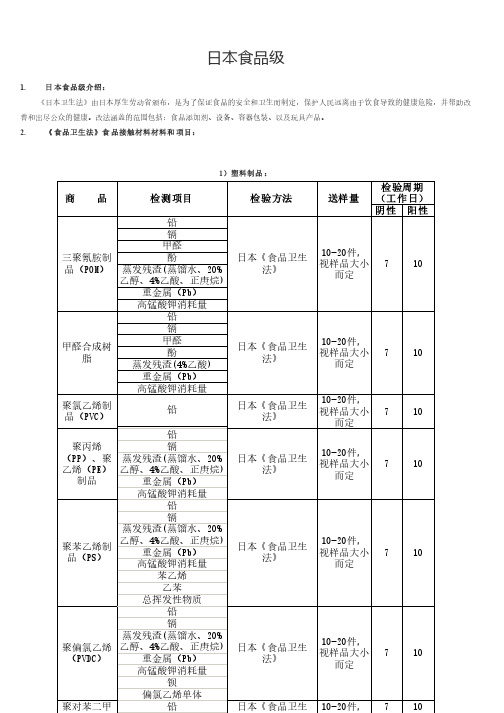
检验方法
铅
镉
甲醛
三聚氰胺制
酚
品(POM) 蒸发残渣(蒸馏水、20%
乙醇、4%乙酸、正庚烷)
重金属(Pb)
高锰酸钾消耗量铅镉 Nhomakorabea甲醛合成树 脂
甲醛 酚
蒸发残渣(4%乙酸)
重金属(Pb)
高锰酸钾消耗量
日本《食品卫生 法》
日本《食品卫生 法》
聚氯乙烯制
铅
品(PVC)
铅
聚丙烯
镉
(PP)、聚 蒸发残渣(蒸馏水、20%
日本食品级
1. 日本食品级介绍:
《日本卫生法》由日本厚生劳动省颁布,是为了保证食品的安全和卫生而制定,保护人民远离由于饮食导致的健康危险,并帮助改 善和出尽公众的健康。改法涵盖的范围包括:食品添加剂、设备、容器包装、以及玩具产品。
2. 《食品卫生法》食品接触材料材料和项目:
1)塑料制品:
商 品 检测项目
10-20件, 视样品大小
而定
7
10
2)橡胶制品:
商品
检测项目
检验方法
非奶嘴橡胶制 品
橡胶奶嘴
蒸发残渣(蒸馏水、20%乙醇、 4%乙酸)
重金属(Pb) 甲醛 酚 锌 镉 铅
2-巯基咪唑 蒸发残渣(蒸馏水)
日本《食品卫生法》 日本《食品卫生法》
送样量
20件 20件
检验周期 (工作日)
阴性 阳性
7
10
7
而定
10-20件, 视样品大小 7 10
而定
10-20件, 视样品大小 7 10
而定
10-20件, 7 10
酸乙二醇酯
镉
法》
视样品大小
(PET) 蒸发残渣(蒸馏水、20%
日本食品接触材料标准详解
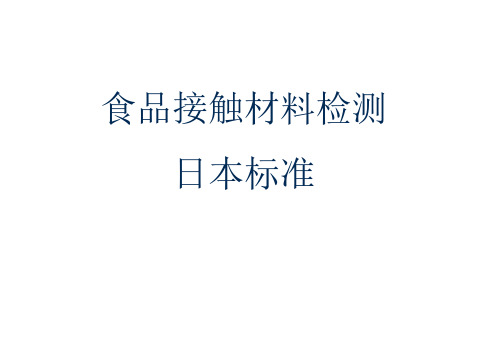
食品接触材料检测日本标准食品接触材料测试的分类食品接触材料测试的分类常见日本食品接触材料测试的分类测试的分类物理测试Physical Test密度、熔点拉伸强度、撕裂强度、穿刺强度 透氧率(OTR)、透水率(WTR)老化试验化学测试Chemical Test★迁移测试 溶剂残留 重金属测试 增塑剂测试 防腐剂测试生物测试Biological Test微生物测试 细胞毒性测试只针对带有颜色的原料Only for materials and articlesRubber and rubberproduct特定物质的释放Release of specificsubstances重金属Heavy Metal重金属(以铅计)Heavy Metalas Lead脱色试验Color MigrationTest总迁移测试OverallMigration Test特殊迁移测试SpecificMigration Test高锰酸钾消耗量Consumption of Potassium Permanganate 蒸发残渣(Evaporation Residue)10. 11.Polymethyl Methacrylate(PM MA)聚甲基丙烯酸甲酯总铅总镉重金属溶出(以铅计)高锰酸钾消耗量蒸馏水中蒸发残渣4%醋酸中蒸发残渣20%乙醇中蒸发残渣正庚烷中蒸发残渣甲基丙烯酸甲酯溶出量Nylon ( PA)尼龙总铅总镉重金属溶出(以铅计)高锰酸钾消耗量蒸馏水中蒸发残渣4%醋酸中蒸发残渣20%乙醇中蒸发残渣正庚烷中蒸发残渣己内酰胺溶出12. 13.Polycarbonate (PC)总铅总镉重金属溶出(以铅计)高锰酸钾消耗量蒸馏水中蒸发残渣4%醋酸中蒸发残渣20%乙醇中蒸发残渣正庚烷中蒸发残渣双酚A含量双酚A、苯酚、4-叔丁基苯酚总含量双酚A溶出双酚A、苯酚、4-叔丁基苯酚总迁移量碳酸二苯酯聚碳酸酯材料中三乙胺和三丁胺含量的测定Phenolic,melamineand urea resins酚醛树脂,密胺和尿素树脂总铅总镉重金属溶出(以铅计)蒸馏水中蒸发残渣4%醋酸中蒸发残渣20%乙醇中蒸发残渣正庚烷中蒸发残渣苯酚溶出甲醛溶出14. 15.Polylactic acid(PLA)聚乳酸总铅总镉重金属溶出(以铅计)蒸馏水中蒸发残渣4%醋酸中蒸发残渣20%乙醇中蒸发残渣正庚烷中蒸发残渣migration of lactic acidRubber(except nursingutensils)橡胶制品(除护理用品)隔铅Phenol(Elution)甲醛溶出锌溶出重金属溶出蒸馏水中蒸发残渣4%醋酸中蒸发残渣20%乙醇中蒸发残渣2-Mercaptoimidazoline(only for rubbercontaining chlorine)16. 17.Rubber (nursing utensils)橡胶制品(护理用品)隔铅Phenol(Elution)甲醛溶出锌溶出重金属溶出蒸馏水中蒸发残渣Metal cans[except thosecontaining driedfoods (except fatsand oils and fattyfoods)] 金属罐(包括盛放油脂和脂肪类食物的容器)砷溶出镉溶出铅溶出甲醛溶出苯酚溶出表氯醇溶出氯乙烯单体溶出蒸馏水中蒸发残渣4%醋酸中蒸发残渣20%乙醇中蒸发残渣正庚烷中蒸发残渣金属材料以及玻璃陶瓷用品Metal(Tin for plating)金属(镀锡)lead铅用于制造或修理包装容器和器具的金属铅和锑用于制造或修理包装容器和器具的焊锡lead铅镉溶出玻璃,陶瓷,搪瓷铅溶出玻璃、陶瓷、搪瓷做铅镉溶出的测试条件需要在暗室中进行日本食品包装器具的制造特殊要求1.铜或者铜制品用作包装容器时,与食品接触部分应该全面镀锡或者镀银,或者采用其他不会在卫生生产商产生危害的措施。
日本食品标签要求简介
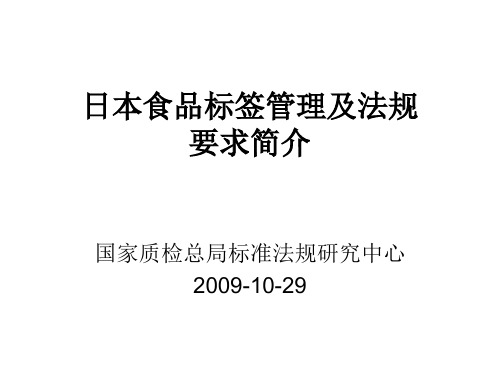
二、食品标签法规标准
• 《食品卫生法》 • 《健康増进法》 • 《农林产品的标准化和正确标签法(JAS 法)》 • 《景品表示法》 • 《计量法》 • 《原子力政策大纲》
具体详细的规定:
• • • • • • 《食品卫生实施条例》 《健康增进法实施条例》 《营养标示基准》 《水果饮料质量表示基准》 《碳酸饮料质量表示基准》 《豆乳类食品质量表示基准》等
某些产品还需标注的内容
• ——矿泉水类,包装容器内二氧化碳压力为 20℃1.0kg/cm2以下,未进行杀菌或灭菌的,应标 示“未经杀菌或灭菌”。 • ——冷冻果汁饮料(指经冷冻的水果榨汁或浓缩 水果榨汁),应标明“冷冻果汁饮料”的字样。 • ——肉食干制品(指销售的干燥肉食制品),应 标明“肉食干制品”。 • ——非加热肉食制品,应标明“非加热肉食制品” 及PH值、水活性。 • ——特定加热肉食制品,应标明“特定加热肉食 制品”及水活性。 • ——加热肉食制品,应标明“加热肉食制品”及 填装于容器后加热杀菌与加热杀菌后填装于容器 之区别。
三、日本食品标签通用要求
• 《食品卫生实施条例》 • 标签包含的主要信息: • 食品名称、配料表、食品添加剂、净含量、 生产日期和保质期、生产厂商的名称和地 址、保存方法或食用方法等。 • 必须 必须将上述标示信息标注于容器或包装的 明显部位,均应使用日文标注,通俗易懂。
通用要求
• 食品名称 • ——食品名称中冠以主要配料名称时,必 食品名称中冠以主要配料名称时, 食品名称中冠以主要配料名称时 须与主要配料一致。 须与主要配料一致。食品名称中加注的主 要配料为两种以上混合物时, 要配料为两种以上混合物时,不能只冠以 一种配料的名称。 一种配料的名称。 • ——特种营养食品须按照批准的产品名称 特种营养食品须按照批准的产品名称 标注。 标注。
日本设定两项农药限量标准

生产 的反应 nl 和能 耗 , 高生产 效率和产 品质 量 。 el ; 提
I f ' " 术相 比有 著的竞 ・ 势 。该 专利于 其' t : g- 技 5 优 2 0 年 9月进 行 P T 请 , 05 C 目前 已在 中I 美 、 、 澳
产 品 L 1 口 4 q:2月 6个 产 品 , 口实 物量 为
3 10吨 , 巾杀 虫剂 1 2 1 其 9 2吨 , 菌剂 9 4 6 8个 4 杀 个 3
吨, 除草剂 1 6个 3 3 2吨 , 长调 节 齐 00 生 I J 3个 4 2吨, 3 累汁实物屋 l4 2 9 8 6吨
大利 、 和越南 5个 家 获得授权 南非
( 来源: 中国化 -4 ) v t -
au iu ) 异 菌 脲 ( ・ in) 高 氟 氯 氰 菊 酯 lm n m 、 1 o o e、 ld n (a b a ch h hi) L m d —y a l r 及环 氧丙烷 (rp ln x e规 t n Poye eO i ) d 定 的最 大残 限量 , 已 式 获得 批 准 。 中 , 其 烯草 酮
十一届 中 专 利 优 秀奖 。 该发 明主要 足采 厅 了一 种 J 新) 的草甘膦 铵盐 制备方 法 ,大幅节省草 甘膦 铵盐
ቤተ መጻሕፍቲ ባይዱ
工厂库存 : 计存 4 4 0吨 , 巾杀 虫剂 5 0 85 其 7 5吨 、 杀菌 剂 1 1 8吨 ,除 草 剂 2 0 1吨 、生 长 调 节 剂 21 97
( 来源 : 中国化 工报 )
In, ] l在洋葱头 上 为 1 p 在 柑橘类 上为 9 p p 0p m, . p m; 0 环 氧 I 在 仁 上 的最 大 残 限量 为 3 0p m。 烷 0 p 上
日本食品防腐剂的使用与标准
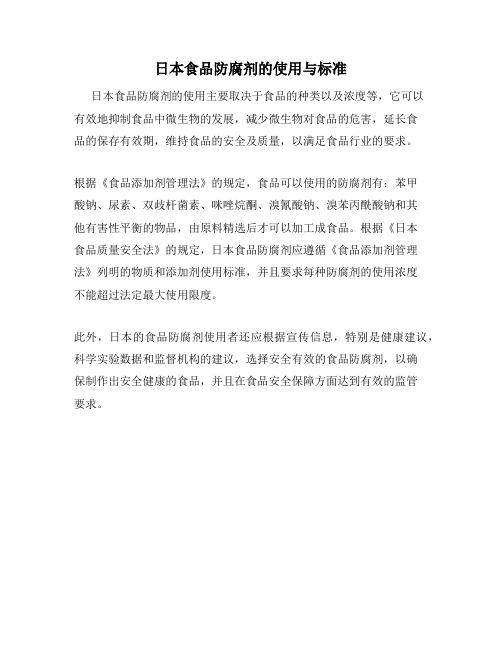
日本食品防腐剂的使用与标准
日本食品防腐剂的使用主要取决于食品的种类以及浓度等,它可以
有效地抑制食品中微生物的发展,减少微生物对食品的危害,延长食
品的保存有效期,维持食品的安全及质量,以满足食品行业的要求。
根据《食品添加剂管理法》的规定,食品可以使用的防腐剂有:苯甲
酸钠、尿素、双歧杆菌素、咪唑烷酮、溴氰酸钠、溴苯丙酰酸钠和其
他有害性平衡的物品,由原料精选后才可以加工成食品。
根据《日本
食品质量安全法》的规定,日本食品防腐剂应遵循《食品添加剂管理法》列明的物质和添加剂使用标准,并且要求每种防腐剂的使用浓度
不能超过法定最大使用限度。
此外,日本的食品防腐剂使用者还应根据宣传信息,特别是健康建议,科学实验数据和监督机构的建议,选择安全有效的食品防腐剂,以确
保制作出安全健康的食品,并且在食品安全保障方面达到有效的监管
要求。
日本拟修订食品添加剂碳酸钙等的使用标准
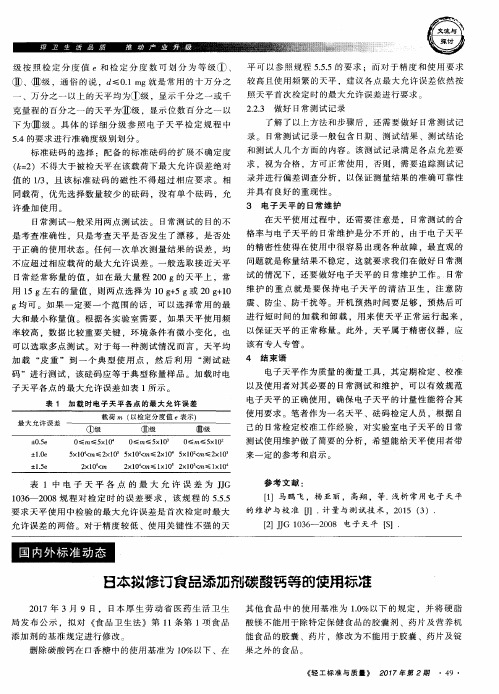
平 可以参 照规程 5 . 5 . 5的要 求 :而 对 于 精 度 和 使 用 要 求 照天平首次检定时的最大允许误差进行要求。
⑩ 、⑩ 级 ,通俗 的说 ,d ≤0 . 1 m g 就 是常用 的十万 分之 较 高 且 使 用 频 繁 的 天 平 ,建 议 各 点 最 大 允 许 误 差 依 然按
5 . 4的要 求 进 行 准 确 度 级 别 划 分 。 录 。 日常 测 试 记 录 一 般 包 含 日期 、测 试 结 果 、测 试 结 论 和 测 试 人 几 个 方 面 的 内 容 。 该 测 试 记 录 满 足 各 点 允 差 要
标 准砝 码 的 选 择 :配 备 的标 准 砝 码 的 扩 展 不 确定 度
用 1 5 g左 右 的量 值 ,则 两 点 选 择 为 1 0 g + 5 g 或2 0 g + 1 0 维 护 的 重 点 就 是 要 保 持 电 子 天 平 的 清 洁 卫 生 。注 意 防 g均 可 。如 果 一 定 要 一 个 范 围 的 话 ,可 以选 择 常 用 的 最 震 、 防尘 、防 干 扰 等 。开 机 预 热 时 间要 足 够 ,预 热 后 可 大 和 最 小 称 量 值 。根 据 各 实 验 室 需 要 ,如 果 天 平 使 用 频 率 较 高 ,数 据 比较 重 要 关 键 ,环 境 条 件 有 微 小 变 化 ,也 可 以 选 取 多 点 测 试 。对 于 每 一 种 测 试 情 况 而 言 ,天 平 均 加载 “ 皮重 ”到一 个典 型使 用点 ,然后 利 用 “ 测 试 砝 码 ”进 行 测试 ,该 砝 码 应 等 于典 型 称 量 样 品 。 加 载 时 电 子 天平 各 点 的 最 大 允 许 误 差 如 表 1 所示 。
日本食品添加剂标准
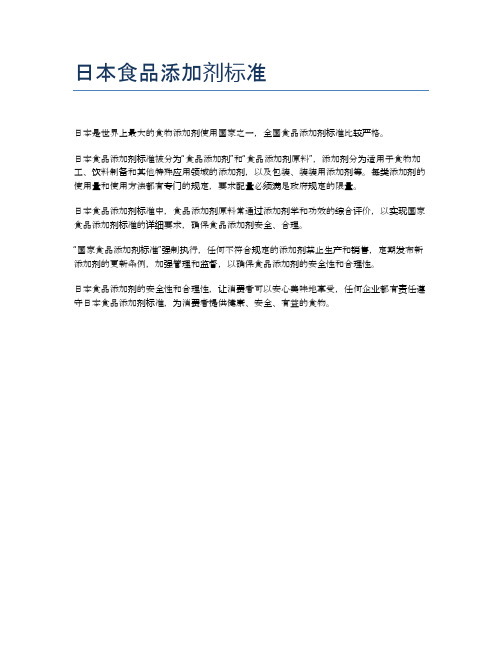
日本食品添加剂标准
日本是世界上最大的食物添加剂使用国家之一,全国食品添加剂标准比较严格。
日本食品添加剂标准被分为“食品添加剂”和“食品添加剂原料”,添加剂分为适用于食物加工、饮料制备和其他特殊应用领域的添加剂,以及包装、装装用添加剂等。
每类添加剂的使用量和使用方法都有专门的规定,要求配量必须满足政府规定的限量。
日本食品添加剂标准中,食品添加剂原料常通过添加剂学和功效的综合评价,以实现国家食品添加剂标准的详细要求,确保食品添加剂安全、合理。
“国家食品添加剂标准”强制执行,任何不符合规定的添加剂禁止生产和销售,定期发布新添加剂的更新条例,加强管理和监督,以确保食品添加剂的安全性和合理性。
日本食品添加剂的安全性和合理性,让消费者可以安心美味地享受,任何企业都有责任遵守日本食品添加剂标准,为消费者提供健康、安全、有益的食物。
输日食品中农药

输日食品中农药、饲料添加剂、兽药残留物质的检测方法食品添加剂等规格基准(1959年日本厚生省告示第370号)中第1 食品A 食品的一般规格成分中第6款表(1)第一栏、第7款表(1)第一栏、第9款表(1)第一栏所列农药、饲料添加剂、兽药的成分物质(包括这些物质的化学衍生物和化学合成物)的检测方法,规定如下(不包括表中第3栏不得检出的物质)。
第一章总则第二章多残留检测方法第三章单类(单一)残留检测方法※『食品中农药、饲料添加剂、兽药残留物质的检测方法』于2005年1月24日厚生劳动省医药食品局食品安全部部长食安发第0124001号通知下发。
第一章总则1.用语(1)」「分析对象物质」是指第2章检测方法中的所分析的化合物、是食品添加剂等规格基准(1959年日本厚生省告示第370号)中第1 食品A 食品的一般规格成分第6款表(1)第一栏、第7款表(1)第一栏、第9款表(1)第一栏所列农药、饲料添加剂、兽药的成分物质(包括这些物质的化学衍生物和化学合成物)及类似物质(如盐类的光学异构体)。
(2)分析值是指告示规定的食品中农药等残留限量同比较检测值。
(3)种子类是指油籽、坚果类、可可豆及咖啡豆等。
(4)定量限:能对样品中含有的分析目标化合物进行定量的最低的量或浓度,使用色谱进行分析时,用S(峰高)/N(基线噪音)之比=10时的分析目标化合物量作为农药等的定量限。
(5)类型是指检测方法的来源,分为以下几类。
A.公定法(关于乳及乳制品的成分规格等的省令)B.各外国政府机构规定的检测方法(A类除外)C.专家研讨会制定的检测方法。
D.引用文献的检测方法。
(A、B、C类除外)。
2.仪器第2章及第3章规定的检测方法进行检测时,当规定使用{气相色谱·质谱进行检测时,即可使用GC/MS也可使用GC/MS/ MS。
当规定使用液相色谱·质谱进行检测时,即可使用LC/MS也可使用LC/MS/ MS。
3.试剂使用第2章及第3章规定的检测方法进行检测时,除同章另有规定,使用告示中第2添加剂C试剂部中1所列的试剂或附件所列的试剂。
- 1、下载文档前请自行甄别文档内容的完整性,平台不提供额外的编辑、内容补充、找答案等附加服务。
- 2、"仅部分预览"的文档,不可在线预览部分如存在完整性等问题,可反馈申请退款(可完整预览的文档不适用该条件!)。
- 3、如文档侵犯您的权益,请联系客服反馈,我们会尽快为您处理(人工客服工作时间:9:00-18:30)。
Major Use Category AdditivesTarget FoodsMaximum LimitsLimitation for UseAcidifiersAcetic Acid All foodsAcetic Acid, Glacial Adipic Acid Citric Acid Fumaric Acid Gluconic Acid Glucono-δ-Lactone Lactic Acid DL-Malic Acid Succinic Acid D-Tartaric Acid DL-Tartaric AcidAnti-cakingFerrocyanides of Calcium,Potassium and SodiumSaltIndividually or in combination,0.020g/kg asanhydrous sodium ferrocyanide Anti-foaming agent Silicone resin All foods0.050 g/kg Only for defoaming.Anti-molding agentsDiphenylGrapefruit 0.070 g/kg Lemon 0.070 g/kg Orange0.070 g/kg ImazalilBanana 0.0020 g/kg Citus fruits0.0050 g/kg(except mandarin orange)o-Phenylphenol Sodium o -Phenylphenol Citrus fruitsThiabendazoleBanana (whole)0.0030 g/kg Banana (pulp)0.0004 g/kg Citrus fruits0.010 g/kgAntioxidantsL-Ascorbic Acid All foods L-Ascorbyl Palmitate L-Ascorbyl StearateButylated Hydroxyanisole (BHA)as BHA Butter 0.2 g/kg Fats & oils0.2 g/kg Fish & shellfish (dried)0.2 g/kg Fish & shellfish (salted)0.2 g/kg Fish & shellfish (frozen)1 g/kg of dip(except frozen products cosumed raw)Mashed potato (dried)0.2 g/kg Whale meat (frozen)1 g/kg of dip(except frozen products cosumed raw)Standards for Use, according to Use Categorieseffective from October 20, 2010When BHA is used incombination with BHT, the total amount of both shall not exceed the corresponding limit.as maximum residue limitas maximum residue limit as maximum residue limit of o -phenylphenol 0.010g /kg as maximum residue limitAntioxidants Butylated Hydroxytoluene as BHA (continued) (BHT)Butter 0.2 g/kgChewing gum0.75 g/kgFats & oils0.2 g/kgFish & shellfish (dried)0.2 g/kgFish & shellfish (salted)0.2 g/kgFish & shellfish (frozen) 1 g/kg of dip(except frozen productscosumed raw)Mashed potato (dried)0.2 g/kgWhale meat (frozen) 1 g/kg of dipCalcium Disodium as EDTA-CaNa2Ethylenediamine-0.035 g/kgtetraacetateOther canned and bottle foods0.25 g/kgL-Cysteine Monohydro-Breadchloride Fruit juiceDisodium Ethylene-as EDTA-CaNa2 diaminetetraacetate0.035 g/kgOther canned and bottled foods0.25 g/kgErythrobic Acid All foodsIsopropyl CitrateButter0.10 g/kgFats and oils0.10 g/kgGuaiac Resin Butter 1.0 g/kgFats and oils 1.0 g/kgPropyl Gallate Butter 0.10 g/kgFats and oils0.20 g/kgSodium L-Ascorbate All foodsSodium Erythorbate All foodsdl-α-Tocopherol All foodsAntisticking D-Mannitol Candies40 %Chewing gum20 %FURIKAKE (sprinkleover onlyproducts containing granues)RAKUGAN (dried rice-flour cakes)30 %25 %All foods as CHOMIRYO (seasoning)*When BHA is used in combination with BHT, the total amount of both shall not exceed the corresponding limit.(except frozen products cosumed raw)Canned and bottle non- alcoholic beveragesCanned and bottle non- alcoholic beveragesShall be chelated withcalcium ino before thepreparation of the finishedfood.Not permitted for nutritivepurposes in fish pasteproducts (excluding SURIMI)or bread.Only for antioxidizingpurposes in other foods.as monoisopropylcitrateNot permitted for nutritivepurposes in fish pasteproducts (excluding SURIMI)or bread.Only for antioxidizingpurposes in other foods.Only for antioxidizing, exceptwhen included in preparationof β-Carotene, Vitamin A,Vitamin A Esters of FattyAcids, or Liquid Paraffin.TSUKUDANI (food boiled down in soy sauce, only products madeof KONBU (kelp))50 % ofgranules(as maximumresidue limit)* When used in formula withPotassium Chloride andGlutamate for seasoningfoods or enhancing theiroriginal flavor, no limits arespecified.(only cases where D-Mannitol does not exceed 80% of the sum of PotassiumChloride, Glutamates and D-Mannitol)Color fixativesFerrous Sulfate All foodsPotassium Nitrateless than:Meat products 0.070 g/kg Whale meat bacon0.070 g/kg (as residue limit of NO 2Sodium Nitrate as maximum Sodium Nitriteresidue limit of nitrite Fish ham 0.050 g/kg Fish sausage0.050 g/kg IKURA (salted/processed 0.0050 g/kg salmon roes)Meat products0.070 g/kg SUJIKO (salted salmon roes)0.0050 g/kg TARAKO0.0050 g/kg Whale meat bacon 0.070 g/kg Color adjuvant Ferrous GluconateTable olive0.15 g/kgDietary SupplementsL-Ascorbic acid 2-glucoside All foodsBiotin Foods with health claims Bisbentiamine All foodsCalcium Carbonate*as Ca Calcium Chloride All foods1.0 %Calcium Citrate Chewing gum*10 % *Calcium Dihydrogen Pyrophosphate Calcium Dihydrogen PhosphateCacium GluconateCalcium Glycerophosphate Calcium HydroxideCalcium Lactate Calcium Monohydrogen All foodsPhosphateCalcium Pantothenate Calcium SulfateCholecalciferolAll foodsSame as for Potassium NitrateThe above limits do not apply to foods approved to be labeled as "special. dietary use."Only when indispensable for manufacturing or processing the food, or when used for nutritive purposes.* Only applied to Calcium CarbonateMay also be used as dietary supplement.See the section, "Dietary supplements"Only for nutritive purposes.Only when indispensable for manufacturing or processing the food, or when used for nutritive purposes.Only when indispensable for manufacturing or processing the food, or when used for nutritive purposes.Only when indispensable for manufacturing or processing the food, or when used for nutritive purposes.May be used as fermentation regulator. See the section,"Miscellenous."Dietary Supplements Copper Gluconateas copper(continued)Substitutes for human milk0.60 mg/LFoods with health claims5 mg/recommended daily portion of each foodCupric Sulfateas copper Substitutes for human milk0.60 mg/LDibenzoyl Thiamine All foodsDibenzoyl Thiamine Hydrochloride Dry Formed Vitamin A ErgocalciferolFerric Ammonium Citrate Ferric Chloride Ferric Citrate Ferric Pyrophosphate Ferrous GluconateDried milk for pregnant and lactating women.Substitutes for human milk.Weaning foodsFolic AcidAll foodsL-Histidine Monohydro- chloride Iron Lactate L-Isoleucine L-Lysine L-Aspartate L-Lysine L-GlutamateL-Lysin Monohydrochloride DL-Methionine L-Methionine Methyl Hesperidin Nicotinamide Nicotinic Acid L-Phenylalanine All foodsPyridoxine Hydrochloride RiboflavinRiboflavin 5'-Phosphate SodiumRiboflavin Tetrabutyrate Sodium Ferrous Citrate Sodium Pantothenate Thiamine Dicetylsulfate Thiamine Dilaurylsulfate Thiamine Hydrochloride Thiamine Mononitratewhen formulated into a standard concentration.The limit does not apply to cases where these additives are used in formulated dried milk under approval by the Minister of Health, Labor and Welfare.Not permitted in freshfish/shellfish (including fresh whale meat) or meat.May also be used as color adjuvant.See the section, "Color adjuvant."when formulated into a standard concentration.The limit does not apply to cases where these additives are used in formulated dried milk under approval by the Minister of Health, Labor and Welfare.Dietary Supplements Thiamine Naphthalene-All foods(continued) 1, 5-disulfonateThiamine ThiocyanateDL-ThreonineL-Threonineall-rac-α-Tocopheryl Acetate Foods with health claims as α-TocopherolR,R,R-α-Tocopheryl Acetate150mg/recommendeddaily portion of eachfoodTricalcium Phosphate All foods as Ca1.0 %DL-Tryptophan All foodsL-TryptophanL-ValineVitamin AVitamin A Esters ofFatty AcidsVitamin A in OilZinc Gluconate Only substitutes for human milk as zincFoods with health claims15 mg/recommended dailyportion of each foodZinc Sulfate Only substitutes for human milk as zincEmulsifiers Calcium Strearoyl Lactylate as Calcium Strearoyl LactylateBread. 4.0 g/kgButter cakes. 5.5 g/kgConfections(baked or fried wheatflour products only).4.0 g/kgMoist cakes (rice flour products only).6.0 g/kgMacaroni and other such products.* 4.0 g/kg**as dry noodles.Mixed powder:for manufacturing bread. 5.5 g/kgfor manufacturing confections(fried wheat flour products only).5.5 g/kgfor manufacturing confections(baked wheat flour products only).5.0 g/kgfor manufacturing moist cakes(rice flour products only).10 g/kgfor manufacturing sponge cakes,butter cakes and steamed breads.8.0 g/kgfor manufacturing steamed MANJYU (bun made by steaming wheat flour dough).2.56.0 mg/LWhen formulatedinto a standardconcentration.Not applied to cases whereOnly when indispensable formanufacturing or processingthe food, or when used fornutritive purposes.The above limit donot apply to foodsapproved to belabeled as"special. dietaryuse."6.0 mg/LWhen formulatedinto a standardconcentration.the additives is used in for-mulated dried milk underapproval by the Minister ofHealth, Labor and Welfare.Not applied to cases wherethe additives is used in for-mulated dried milk underapproval by the Minister ofHealth, Labor and Welfare.When used in combinationwith calcium strearoyllactylate and sodiumstrearoyl lactylate, totallevel of the additives ascalcium strearoyl lactylateshall not be more than themaximum limit.Emulsifiers Calcium Strearoyl Lactylate Noodles (excluding instant noodles and dry noodles) 4.5 g/kg**** as boiled noodles.(continued)(continued)Sponge cakes.5.5 g/kg Steamed bread (bread made by steaming wheat flour dough). 5.5 g/kg Steamed MANJYU2.0 g/kgGlycerol Esters of Fatty All foodsAcids LecithinPolysorbate 20as polysorbate 80Polysorbate 60 Capsule- and tablet-form foods excluding confections 25 g/kg Polysorbate 65 Chewing gum5.0 g/kg Polysorbate 80Cocoa and chocolate products 5.0 g/kg Milk-fat substitutes 5.0 g/kg Sauces5.0 g/kg Seasonings for instant noodles 5.0 g/kg Shortening5.0 g/kg Bakery confections3.0 g/kg Decorations for confections 3.0 g/kg (Sugar coatings and icings) Dressing 3.0 g/kg Ice creams 3.0 g/kg Mayonnaise3.0 g/kg Mix powder for bakery confections and moist sweet cake3.0 g/kg Moist sweet cake, unbaked cake 3.0 g/kg(Including fruit tart, cream cake, rare cheese cake, custard pudding, and like products)Sweetened yoghurt 3.0 g/kg Candies1.0 g/kg Edible ices including sherbet 1.0 g/kg Flour paste* 1.0 g/kg Soup1.0 g/kg Pickled sea weed 0.50 g/kg Pickled vegetables 0.50 g/kg Chocolate drinks 0.50 g/kg Unripened cheese0.080 g/kg Canned and bottled sea weed 0.030 g/kg Canned and bottled vegetables 0.030 g/kg Other foods 0.020 g/kgPropylene Glycol Esters All foodsof Fatty AcidsSodium Stearoyl Lactylate Sorbitan Esters of Fatty All foodsAcidsSucrose Esters of Fatty AcidsFilm-forming agentsMorpholine Salts of Fatty Acids Rind of fruits Polyvinyl Acetate*Rind of vegetablesSodium OleateFlavoring agents AcetaldehydeAll foodsOnly for flavoring.AcetophenoneAliphatic Higher Alcohols (excluding substances generally recognized as highly toxic)If it is used together with one of polysorbate 60, 65, and 80,the sum of each amount used shall be not more than the corresponding maximum levels as polysorbate 80. The above standards are not applied for products that are approved or recognized as foods for special dietary use.Flour paste*: In this list, flour paste is confined to paste products of cocoa andchocolate that are prepared with sugar, fat/oil, powder milk,egg, or wheat flour as secondary ingridients, and pasteurized. They are used as fillings or coatings of bread or bakery confections.* Polyvinyl Acetate may also be used as chewing gum base.See the section, "Chewing gum base."Only as film-forming agent.Same as for Calcium Strearoyl LactylateFlavoring agents Aliphatic Higher Aldehydes(continued) (excluding substancesgenerally recognized ashighly toxic)Alphatic Higher Hydro-All foods Only for flavoring.carbons (excluding sub-stances generally recog-nized as highly toxic)Ally CyclohexylpropionateAlly HexanoateAlly IsothiocyanateAmylalcoholα-AmylcinnamicaldehydeAnisaldehydeAromatic AlcoholsAromatic Aldehydes(excluding substancesgenerally recognized ashighly toxic)BenzaldehydeBenzyl Acetate.Benzyl AlcoholBenzyl Propionated-BorneolButanolButyl AcetateButyl ButyrateButyraldehydeButyric AcidCinnamic AcidCinnamaldehydeCinnamyl AcetateCinnamyl AlcoholCitralCitronellalCitronellolCitronellyl AcetateCitronellyl FormateCyclohexyl AcetateCyclohexyl ButyrateDecanalDecanol2,3-Dimethylpyrazine2,5-Dimethylpyrazine2,6-DimethylpyrazineEstersEthersFlavoring agents Ethyl AcetateAll foods(continued)EthanolYeast extract Vinyl acetate resinEthyl Acetoacetate All foods Only for flavoring.Ethyl Butyrate Ethyl Cinnamate Ethyl Decanoate Mixture of2-Ethyl-3,5-dimethylpyrazine and 2-Ethyl-3,6-dimethylpyrazine Ethyl Heptanoate Ethyl Hexanoate Ethyl Isovalerate 2-Ethyl-3-methylpyrazine 2-Ethyl-5-methylpyrazine Ethyl Octanoate Ethyl Phenylacetate Ethyl Propionate 2-Ethylpyrazine Ethylvanillin 1,8-Cineole Eugenol Fatty AcidsFurfural and its derivatives (excluding substances generally recognized as highly toxic)Geraniol Geranyl Acetate Geranyl Formate Hexanoic Acid Hydroxycitronellal Hydroxycitronellal Di- methylacetalIndole and its derivativesOnly for flavoring, execpt when:1. Used for denaturing ethanol which is used for the removal astringency of persimons, the manufacture of crystalline fructose, the preparation of granules or tablets of spices, or the manufacture of KONNYAKU-KO (Konjac powder), or which is used as a solvent for Butylated Hydroxytoluene of Butylated Hydroxyanisole or as aningredient for the manufacture of vinegar;2. Used for accelerating-yeast-autolysis in the extract (water-soluble fraction obtained by autolysis of yeast;)3. Used as a solvent for vinyl acetate resin.Ethyl Aceteta used in manu-facturing yeast extract shall be removed before the preparation of the finished food.Flavoring agents Ionone(continued)Isoamyl AcetateIsoamylalcohol All foods Only for flavoring.Isoamyl ButyrateIsoamyl FormateIsoamyl IsovalerateIsoamyl PhenylacetateIsoamyl PropionateIsobutanolIsobutyraldehydeIsobutyl PhenylacetateIsoeugenolIsopentylamineIsopropanolIsothiocyanates(excluding substances generallyrecognized as highly toxic)IsovaleraldehydeKetonesLactones(excluding substancesgenerally recognized ashighly toxic)LinaloolLinalyl AcetateMaltoldl-Mentholl-Mentholl-Menthyl AcetateMethyl Athranilate2-Methylbutanol3-Methyl-2-butanol2-MethylbutyraldehydeMethyl CinnamateMethyl N-Methylanthra-nilateMethyl β-Naphthyl Ketone6-Methylquinoline5-Methylquinoxaline2-MethypyrazineMethyl Salicylatep-Methylacetophenoneγ-NonalactoneOctanal2-Pentanoll-PerillaldehydePhenethyl AcetatePhenols(excluding substancesgenerally recognized ashighly toxic)Flavoring agents Phenol Ethers(continued) (excluding substancesgenerally recognized ashighly toxic)PiperonalPropanolPropionaldehydePropionic Acid*Terpene HydrocarbonsTerpineolTerpinyl Acetate5,6,7,8-Tetrahydroquinoxaline2,3,5,6-Tetramethylpyrazine All foods Only for flavoring.Thioethers(excluding substancesgenerally recognized ashighly toxic)Thiols(excluding substances generallyrecognized as highly toxic)2,3,5-Trimethylpyrazineγ-UndecalactoneValeraldehydeVanillinFlour treatment agents Ammonium Persulfate Wheat flour0.30 g/kgBenzoyl Peroxide Wheat flourChloride Dioxide Wheat flourDiluted Benzoyl Peroxide Wheat flour0.30 g/kgPotassium Bromate Bread (only products made of wheat0.030 g/kg of wheatflour) flourFood Colors Annato, water-solubleβ-CaroteneCan be used only as diluted Benzoyl Peroxide by mixing with one ormore of Alum, calcium salts of Phosphoric Acid, Calcium Sulfate, Calcium Carbonate, Magnesium Carbonate, and Starch.Not permitted in fresh fish/ shellfish including (fresh whale meat), KONBU (kelp)/ WAKAME (sea weed) (both Laminariales), legumes/ pulses, meat NORI (laver), tea, or vegetables.Shall be decomposed or removed before the preparation of the finished food.Not permitted in fresh fish/ shellfish (including whale meat), KONBU(kelp)/WAKAME (sea weed) (both Laminariales), legumes/pulses, meat, NORI (laver) (except when gold is used on NORI), tea leaves, or vegetables.* Propionic Acid may also be used as preservative. See the section, "Preser-vatives."Food Colors Copper Chlorophyllas copper (continued)0.0004 g/kgChewing gum 0.050 g/kg Chocolate0.0010 g/kg Fish-paste products 0.030 g/kg (excluding SURIMI)Fruits and vegetables for preserva-0.10 g/kgtion.*KONBU (kelp)0.15 g/kg of dry kelp Copper Chlorophyll Moist cakes (excluding bread with 0.0064 g/kg(continued)sweet fillings or toppings)Food Blue No. 1 (Brilliant Blue FCF) and its Alumi- num LakeFood Blue No. 2 (Indigo Carmine) and its Alumi- num LakeFood Green No. 3 (Fast Green FCF) and its Alu- minum LakeFood Red No. 2 (Amaranth) and its Aluminum Lake Food Red No. 3 (Erythro- sin) and its Aluminum Lake Food Red No. 40 (Allura Red) and its Aluminum LakeFood Red No. 102 (New Coccine)Food Red No. 104 (Phloxine)Food Red No. 105 (Rose Bengale)Food Red No. 106 (Acid Red)Food Yellow No. 4 (Tartra- zine) and its Aluminum LakeFood Yellow No. 5 (Sunset Yellow) and its Aluminum LakeFood colors other than chemically synthesized food additivesIron SesquioxideBanana (stem only)KONNYAKU (konjac)Agar jelly in MITSUMAME (prepared by mixing agar jelly,cut fruits, gree beans, etc. with sugar syrup) packed into cans or plastic containers.* Foods which are processed for preserving, including dried foods, salted foods, pickled foods in vinegar, and preserved foods in syrup.Not permitted in fish pickles,fresh fish/shellfish (including whale meat) KASUTERA (a type of pound cake), KINAKO (roasted soybean flour),KONBU (kelp)/WAKAME (sea weed) (both Laminariales ),legumes/pulses, marmalade,meat, meat pickles, MISO (fermented soybean paste),noodles (including Wantan),NORI(laver), soy sauce,sponge cakes, tea leaves,vegetables, or whale meat pickles.Not permitted in fresh fish/shellfish (including whale meat), KONBU(kelp)/WAKAME (sea weed)(both Laminariales ),legumes/pulses, meat, NORI (laver) (except when gold is used on NORI), tea leaves, or vegetables.Food Colors Preparations of tar colors Same as for Food Blue No. 1.(continued)Sodium Copper Chlorophyllin as copper0.0004 g/kgCandies0.020 g/kg Chewing gum 0.050 g/kg Chocolate0.0064 g/kg Fish-paste products (except SURIMI)0.040 g/kg Fruits and vegetables for preserva-0.10 g/kgtion.*KONBU (kelp)0.15 g/kg of dry kelp Sodium Copper Chlorophyllin Moist cakes (excluding bread with 0.0064 g/kg (continued)sweet fillings or toppings)Syrup0.064 g/kgSodium Iron ChlorophyllinTitanium DioxideHumectant Sodium Chondroitin SulfateFish sausage 3.0 g/kg Mayonnaise 20 g/kg Dressing20 g/kg Insecticide Piperonyl Butoxide Cereal grains0.024 g/kg Non-nutritive Sweeteners Acesulfame PotassiumAn (sweetened bean paste) 2.5 g/kg Confectionary 2.5 g/kg Chewing gum5.0 g/kg Edible ices (including sherbets, 1.0 g/kgflavored ices, and other similar foods)Fermented milk*0.50 g/kg Flour paste 1.0 g/kg .Ice creams1.0 g/kg Jam1.0 g/kg Foods with health claims 6.0 g/kg (only tablets)Lactic acid bacterial bevarages* 0.50 g/kg Milk drinks*0.50 g/kg Miscellaneous alcoholic beverages*0.50 g/kg Moist cakes2.5 g/kg Nonalcoholic beverages0.50 g/kgAgar jelly in MITSUMAME (pre-pared by mixing agar jelly, cut fruits, gree beans, etc. withsugar syrup) packed into cans or plastic containers.* Foods which areprocessed for preserving,including dried foods, salted foods, pickled foods in vinegar, and preserved foods in syrup.Only for coloring.Not permitted in fish pickles,fresh fish/shellfish (including whale meat) KASUTERA (a type of pound cake), KINAKO (roasted soybean flour),KONBU (kelp)/WAKAME (sea weed) (both Laminariales ),legumes/pulses, marmalade,meat, meat pickles, MISO (fermented soybean paste),noodles (including Wantan),NORI(laver), soy sauce,sponge cakes, tea leaves,vegetables, or whale meat pickles.* Applied to dilutions, in the case of concentrated products.These maximum limits do not apply to foods approved to be labeled as special dietary use.Same as for Annato,water-solubleNon-nutritive sweeteners Acesulfame Potassium Pickles 1.0 g/kg (continued)(continued)Sugar substitutes**15 g/kgTare (a dip or sauce mainly for 1.0 g/kgJapanese or Chinese foods)Wine*0.50 g/kgOther foods 0.35 g/kg AspartameDisodium Glycyrrhizinate MISO (fermented soybean paste)Soy sauceSaccharin Chewing gum0.050 g/kgSodium Saccharin as residue limitof sodium saccharineless than:KOZI-ZUKE (preserved in KOJI, 2.0 g/kgfermented riceSU-ZUKE (vinegar-pickled foods)TAKUAN-ZUKE (rice bran-pickledradishes)Nonalcoholic beverages (powdered) 1.5 g/kgKASU-ZUKE (lee-pickled foods) 1.2 g/kgMISO-ZUKE (MISO-pickled foods)SHOYU-ZUKE (soy sauce-pickledfoods)Fish/shellfish (processed, excludingfish paste, TSUKUDANI (foodsboiled down with soy sauce),pickles, and canned or bottledfoods)Processed sea weeds0.50 g/kgSimmered beansSoy sauceTSUKUDANI (foods boiled down withsoy sauce)Edible ices0.30 g/kgFish pasteLactic acid bacterial drinksMilk drinksNonalcoholic beveragesSaucesSyrupVinegarAn (sweetened bean paste)0.20 g/kgFermented milkFlour pasteIce cream productsJamsMISO (fermented soybean paste)Pickles (preserved or pickled foods,excluding those listed in thiscolumn)Confectionary0.10 g/kgCanned or bottled foods, excluding 0.20 g/kgthose listed above.** Products used bydirectly adding to drinks, such as coffee and tea. These maximum limits do not apply to foodsapproved to be labeledas special dietary use.(less than 1.5 g/kg in case of materials for nonalcoholic beverage or lactic acid bacteria drinks or fermented milk product to be diluted not less than 5-fold before use, less than 0.90 g/kg in case of vinegar to be deluted not less than 3-fold before use)Non-nutritive sweeteners D-Sorbitol All foods(continued)Sucralose Chewing gum 2.6 g/kgConfectionary 1.8 g/kgJam 1.0 g/kgLactic acid becterial beverages*0.40 g/kgMilk drinks*0.40 g/kgMiscellaneous alcoholic bverages*0.40 g/kgMoist cakes 1.8 g/kgNonalcoholic beverages*0.40 g/kgSake*0.40 g/kgSake (compounded)*0.40 g/kgSugar substitutes**12 g/kgWine (any kind of fruit wine)*0.40 g/kgOther foods0.58 g/kgXylitol All foodsD-XylosePreservatives Benzoic Acid Caviar 2.5 g/kgMargarine 1.0 g/kgNonalcoholic beverages0.60 g/kgSoy sauce0.60 g/kgSyrup0.60 g/kgButyl p-Hydroxybenzoate as p-hydroxybenzoicacidFruit sauce0.20 g/kgnonalcoholic beverages0.10 g/kgRind of fruits and fruit vegetables 0.012 g/kgSoy sauce0.25 g/LSyrup0.10 g/kgVinegar0.10 g/LCalcium Propionate as propionic acidBread and cakes 2.5 g/kgCheese 3.0 g/kgCalcium Sorbate as sorbic acid0.30 g/kgAN (sweetened bean paste) 1.0 g/kgCandied cherries 1.0 g/kgCheese 3.0 g/kgDried fish/shellfish (excluding 1.0 g/kgsmoking cuttlefish & octopus)Dried prune0.50 g/kgFermented milk (as raw materials for0.30 g/kglactic acid bacterial drinks)Fish-paste products (excluding 2.0 g/kgSURIMI)** Products used by directly adding to drinks, such as coffee and tea.* Applied to dilutions, in the case of concentratedproducts.These maximum limits do not apply to foods approved to be labeled as special dietary use.When the additive is used in margarine with Sorbic Acid, Calcium Sorbate or Potassium Sorbate, or a preparation containing these additives, the total amount of them as benzoic acid and as sorbic acid shall not be more than 1.0 g/kg.When the additive is used in cheese with Sorbic Acid, Potassium Sorbate, or Calcium Sorbate or a preparation containing these additives, the total amount of them as propionic acid and as sorbic acid shall not be more than 3.0 g/kg.AMAZAKE (beverages made fromfermneted rice using KOJI (Asp.oryzae), and confined toproducts to be coonsumed in 3-fold or more dilution.)Cheese: When used incombination with propionicacid, calcium propionate, orsodium propionate, totallevel of the additives assorbic acid and as propionicacid shall not be more than3.0 g/kg.Preservative Potassium Sorbate Flour paste products for bread and 1.0 g/kg (continued)(continued) confectionaryFruit juice (including concentrated 1.0 g/kgfruit juice) for confectionaryFruit paste for confectionary 1.0 g/kgGnocchis 1.0 g/kgJams 1.0 g/kgKASU-ZUKE (lees-pickled foods) 1.0 g/kgKetchup0.50 g/kgKOJI-ZUKE (KOJI (Asp. oryzae)- 1.0 g/kgpickled foods)Lactic acid bacterial beverages (ex-0.050 g/kgcluding sterilized bevarages)Lactic acid bacterial beverages (as 0.30 g/kgingredients of lactic acid bacterialbeverages, excluding sterilizedbeverages)Margarine 1.0 g/kgMeat products 2.0 g/kgMiscellaneous alcoholic beverages 0.20 g/kgMISO (fermented soy bean paste) 1.0 g/kgMISO-ZUKE (MISO-pickled foods) 1.0 g/kgSalted vegetables 1.0 g/kgSea urchin products 2.0 g/kgSHOYU-ZUKE (soy sauce-pickled 1.0 g/kgfoods)Simmered beans 1.0 g/kgSmoked cuttlefish & octopus 1.5 g/kgSoup (excluding potage-type soup)0.50 g/kgSU-ZUKE (vinegar-pickled foods)0.50 g/kgSyrup 1.0 g/kgTAKUAN-ZUKE (rice bran-pickled 1.0 g/kgradish)TARE (a dip or sauce mainly for 0.50 g/kgJapanese or Chinese foods)TSUKUDANI (foods boiled down in 1.0 g/kgsoy sauce)TSUYU (a sauce mainly for Japanese0.50 g/kgnoodles)Whale meat products 2.0 g/kgWine (any kind of fruit wine)0.20 g/kgEthyl p-HydroxybenzoateIsobutyl p-Hydroxybenzoate Isopropyl p-Hydroxybenzoate Same as for Butyl p-Hydroxybenzoate.When the additive is usedin margarine with BenzoicAcid or Sodium Benzoate,the total amount of themas benzoic acid and assorbic acid shall not bemore than 1.0 g/kg.When the additive is used inMISO-ZUKE, the totalamount of Sorbic Acid usedin the product, and SorbicAcid and its salts cntainingin MISO as ingredient shallnot be more than 1.0 g/kg.Preservative NisinAs polypeptide containing Nisin A(continued)Cheese (except processed cheese)0.0125g/kgMeat products Whipped creams Dressing 0.010g/kgMayonnaise Sauces*Fine bakery products 0.00625g/kgProcessed cheeseMISO (fermented soybean paste)0.0050g/kgProcessed eggs productsMoist, unbaked, sweet cakes made maainly of cereal grains or starch**0.0030g/kgPotassium Sorbate Propionic AcidPropyl p -Hydroxybenzoate Sodium Benzoateas benzoic acid Caviar2.5 g/kg 1.0 g/kgMargarine1.0 g/kg Nonalcoholic beverages 0.60 g/kg Soy sauce 0.60 g/kg Syrup0.60 g/kgSodium DehydroacetateButter 0.50 g/kg Cheese 0.50 g/kgMargarine0.50 g/kgSodium Propionate Sorbic Acidas sorbic acid 0.30 g/kgAN (sweetened bean paste) 1.0 g/kg Candied cherries1.0 g/kgSame as for Calcium PropionateSame as for Butyl p-HydroxybenzoateFruit paste and fruit juice (includingconcentrated juice) used for manufacturing confectionary.as dehydroacetic Same as for Calcium PropionateAMAZAKE (beverages made from fermneted rice using KOJI (Asp . oryzae ), and confined to products to be coonsumed in 3-fold or more dilution.)This additive may also be used as flavoring agent.See the section, "Flavoring agents."The maximum use levels are not apply to products permmited or recognized by the Minister of Health,Labour and Welfare as foods for special dietary uses. The foods include five types of products: foods for the ill, milk powder for pregnant and lactating women, formulated milkpowder for infants, foods for the aged, foods for specified health uses.* Sauces refer to all kinds of sauces including Oriental thick Worcester sauce,cheese souce, and ketchup,but excluding fruit sauce and its analogues used for cakes.** They refer to rice pudding and tapioca puding, and their analogues, but excluding Oriental sweet dumplings.Same as for Calcium Sorbate When the additive is used in margarine with Sorbic Acid,Calcium Sorbate orPotassium Sorbate, or a preparation containing these additives, the total amount of them as benzoic acid and as sorbic acid shall not be more than 1.0 g/kg.。
